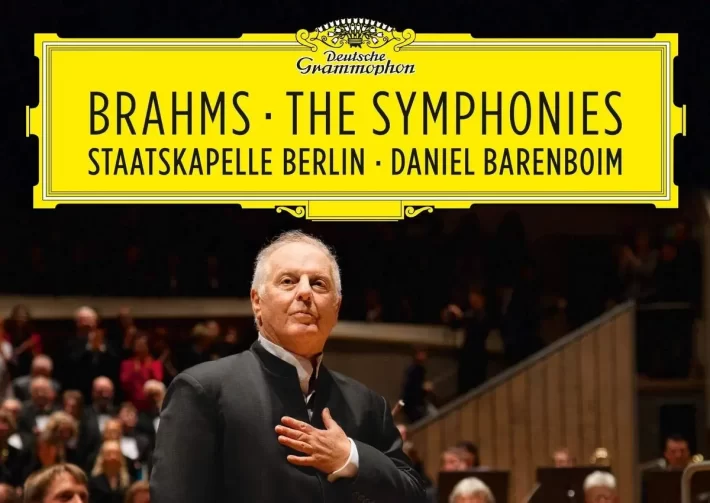Having given us full cycles of Beethoven, Schumann, Bruckner and Elgar, it’s all but natural that Barenboim would like to leave a Brahms cycle for prosperity with the orchestra he resurrected – The Staatskapelle Berlin. There were some very nicely done versions of Brahms cycles of late, with the Boston Symphony under Andris Nelsons the one that perhaps stood out the most. And Barenboim is in direct competition with himself, with a not-too-shabby version he made in the 1990’s with the Chicago Symphony Orchestra (Teldec).

The recording was made in the new Pierre Boulez hall, under studio conditions, but it sounds completely “live”, like sitting in a good sit in a classical music concert. Some listeners may be a bit put-off by this. As anyone that visits a good classical hall knows, there is a different balance to the orchestra when listening to it in a hall, including instruments mingling or covering each other in climaxes. This may not satisfy record listeners who wish to hear each and every one of the section clearly, but that was what the composer intended nonetheless. Brahms know, after all, when hearing his Symphony No. 4 played for the first time in Meiningen, didn’t he know that the brass section is covering up the string sections in the final Fortissimos of the finale? Or the way a real chaos which emerges in the first Symphony’s first movement (“9:40 in this recording)? The recording and acoustic here is an almost active participant, as was in the Nelsons release, from the Wonderful Boston Symphony Hall.
There are very few cycles of the Brahms Symphonies (Perhaps all Symphony cycles), that all of the pieces in the cycle are performed in equal success. There’s always a highlight, a piece or two out of the cycle that stands out. But Barenboim is getting close to getting high ranked for all symphonies. All have their unique moments and each performance of a single Symphony can be recommended along with the best. Having said that, I feel it’s the First Symphony that is the most memorable in this cycle, followed by a heartfelt performance of the Fourth Symphony and Second Symphonies
Barenboim maybe starts the First Symphony a tad hesitantly compared to other conductors – Let’s say Karajan’s violent attack – But the consistent approach in the cycle is the way Barenboim thinks in long lines, paving the way to the high point of the musical idea to the utmost effect. You could say there is some Klemperer influence here, and some choices in phrasing and tempo do remind us of the old master. The difficult little accelerando (Picking up the pace) in the final movement of the first Symphony is a wonder to hear (How can dozens of players hold it together while sounding so flexible? – “6:30 onward). It’s a Brahms’ first for prosperity indeed, one of the most impressive we have come across in recent years, and it should be treasured.
The Second Symphony’s first movement is a good point of reference when comparing the Barenboim Chicago cycle to Berlin’s. The American orchestra is probably more concise, intonation is perfect to the pitch. But hear how magical is the quiet first entrance of the strings is compared to the matter-of-fact way the Chicagoans present themselves in their version.
Barenboim way with the famous second subject is subdued as before, but then again it makes the climaxes that come after it much more effective. This is a long-term view that “sacrifices” a moment of indulgence for the true high point of the musical idea that come at “4:15 (a perfect-sounding blend of orchestra sections if I ever heard one). The difficult transitions in this Symphony are expertly done by players and conductor alike – Listen for example to the return of the second theme in the first movement from 10:15 onward. This is much less memorable in the Chicago version.
If there is a weak point in this cycle, it’s the performance of the Third Symphony, that although dedicatedly played, it pales compared to the other Symphonies in the cycle, not to mention the Chicago version which was more memorable. There is also some odd noises coming from the recording (maybe page turning?) and some noticeable editing patches. The famous Poco Allegretto fails to register and sounds a little sluggish. The final movement exhibits the Berlin sound in all of its glory, but lacks some rhythmic exuberance. All-in-all there are some better alternatives for fans of the Third, and it was one of the high points of the Nelsons release.
Moving to the great Fourth Symphony, Barenboim and the Staatskapelle are back to their true best. It’s a performance that needs some time getting used to, especially if you were used to listening to other great performances from the past of this intricate, vulnerable piece. Barenboim treats this Symphony more as a chamber work than a grand orchestral sounding showpiece, and again, he takes his time reaching the high points of each movement. You would never guess listening to the masterful hushed opening of the first movement the amount of force and volume they orchestra reaches at the Coda. The pizzicato based melody at “3:08 of the second movement is well prepared in advance, but never dwelled into accessibly like in some other versions. It’s flowing, warm, unexaggerated and sound just right. It’s a second movement very nicely done indeed.
The third movement is less hectic and much more playfully graceful than the robust Chicago version (The percussionists clearly enjoying themselves), and the finale “Chaconne” form is perfectly judged and executed – Listen for example to the different sections of the orchestra playing and accompanying each other at “1:08. Barenboim clearly takes his time here, but with the benefit of great transparency that allows us to hear it all. with some magical solo playing from the woodwind section (A magical flute, clarinet and oboe solos from 3’30”).
This is a Brahms complete Symphonies cycle to treasure, then, along with the recent wonderful (but different) Boston cycle under nelsons. Barenboim will not replace other versions from the vast history of Brahms cycles – Karajan from the 70’s, Jochum stereo version with the LPO, Abbado with the BPO, not to mention the almighty Klemperer with the Philharmonia, Szell, Walter, and my personal favorite – Gunter Wand second live cycle with the NDR Orchestra. I could go on, But this current release will keeps on giving with each repeated listening. I for one will most definitely listen to it many times over.

Album Details |
|
|---|---|
| Album name | Brahms – Symphonies 1–4 |
| Label | Deutsche Grammophon |
| Catalogue No. | 4835251 |
| Artists | Staatskapelle Berlin; Daniel Barenboim, conductor |



















